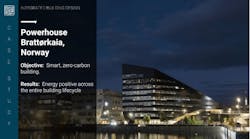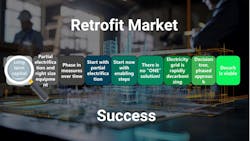How Tech Will Revolutionize Decarbonization
By KENT W. PETERSON, P.E., FASHRAE, Chair, The ASHRAE Center of Excellence for Building Decarbonization (CEBD)
Addressing climate change is more pressing than ever, and the built environment plays a significant role in this global challenge. Buildings are responsible for a substantial portion of global carbon emissions, making it imperative for the construction industry to innovate and adopt new strategies for decarbonization.
This article explores how emerging technologies can revolutionize building design, construction, and operation, propelling us toward a sustainable and decarbonized future.
Embracing Nature's Efficiency
Nature, exemplified by the forest ecosystem, operates on principles of sustainability and efficiency, with no concept of waste. Every element contributes to the cycle of life, creating a balanced and self-sustaining system. This natural model inspires the concept of the circular economy, where waste is minimized, and materials are continuously reused and recycled. By emulating nature, we can create efficient and environmentally friendly buildings.
The forest serves as a metaphor for the ideal built environment. In a forest, fallen leaves decompose and enrich the soil, supporting new plant growth and maintaining a balanced ecosystem. This cycle of life is sustainable and efficient, highlighting the importance of designing buildings that operate with similar principles. By integrating natural processes into building design, we can reduce waste, improve resource efficiency, and create spaces in harmony with the environment.
Unlike natural systems, human activities often lead to significant waste and inefficiency. Landfills accumulate materials that could be recycled or reused, highlighting missed opportunities for more sustainable resource management. Similarly, energy consumption is often wasteful. As we continue to improve our quality of life through technology, we must address the environmental impact and ensure that future generations inherit a sustainable world.
Current waste management methods, particularly landfills, exemplify the inefficiency of human systems. Many materials in landfills could be recycled or repurposed, reducing the strain on natural resources and minimizing environmental impact. In the same vein, energy consumption in buildings is frequently characterized by inefficiencies that result in unnecessary carbon emissions. Addressing these issues requires a comprehensive waste and energy management approach, incorporating advanced technologies and innovative practices.
Building Toward Decarbonization
Building decarbonization involves reducing greenhouse gas (GHG) emissions throughout a building's lifecycle. This journey aims to achieve near-net-zero emissions from buildings by 2050. GHG emissions from buildings are categorized into operational and embodied carbon.
Operational carbon includes emissions from energy used to heat, cool, and power buildings, while embodied carbon encompasses emissions from the materials and construction processes.
In 2022, according to industry estimates, buildings accounted for 38% of energy-related CO2 emissions, underscoring the critical need for decarbonization.
Addressing both operational and embodied carbon is essential to creating a sustainable future. Operational carbon emissions are generated during a building's use phase, primarily from heating, cooling, lighting, and powering various systems. In contrast, embodied carbon emissions arise from the production, transportation, and installation of building materials and construction activities.
Achieving decarbonization requires a holistic approach that considers a building's entire lifecycle. From the initial design phase to construction, operation, and eventual demolition, each stage presents opportunities to reduce carbon emissions. This lifecycle perspective ensures that decarbonization efforts are comprehensive and effective, addressing immediate and long-term environmental impacts.
Technologies Driving Decarbonization
Energy Efficiency and Renewable Energy
The most sustainable energy is the energy we don't use. Reducing energy consumption through efficiency and conservation is more effective than generating new energy, even from renewable sources.
Heat pumps, for instance, provide efficient heating and cooling solutions, significantly reducing carbon emissions. These systems can operate using various energy sources, including air, water, and ground, and achieve 200-550% efficiencies through the refrigeration cycle.
Heat pumps are a cornerstone of decarbonization efforts in building design. They can achieve high-efficiency levels and significantly reduce energy consumption by transferring heat rather than generating it. This technology is particularly effective in regions with moderate climates, where the temperature difference between the heat source and the heat sink is relatively small. Advanced heat pump systems can still provide substantial energy savings in colder climates by leveraging geothermal or water sources.
Beneficial Electrification
Replacing fossil fuel use with electricity can reduce overall emissions and improve building efficiency. As electricity's carbon intensity continues to decline, strategic electrification becomes a viable pathway to decarbonization. Beneficial electrification involves the intentional shift from direct fossil fuel use to electricity in applications when it reduces overall emissions and enhances efficiency.
Transitioning to electric heating and cooling systems is key to beneficial electrification. Electric systems, particularly when powered by renewable energy sources, offer significant environmental benefits over traditional fossil fuel-based systems. However, the success of this transition depends on the availability of low-carbon electricity. As the grid increasingly incorporates renewable energy, the carbon intensity of electricity will continue to decrease, making electrification an even more attractive option.
Building Information Modeling (BIM)
BIM optimizes energy efficiency, reduces waste, and facilitates collaboration throughout the building lifecycle. By leveraging BIM, the construction industry can sustainably design, construct, and operate buildings. BIM fosters collaboration among architects, engineers, contractors, and facility managers by providing a common platform for sharing information. This integrated approach ensures that sustainability and decarbonization goals are considered at every stage of the building lifecycle.
BIM enables detailed simulations and analyses that can optimize building performance. By modeling various design scenarios, stakeholders can identify the most energy-efficient and sustainable options. BIM also supports integrating renewable energy systems, advanced HVAC technologies, and other sustainable features into building designs. This holistic approach not only improves building performance but also reduces costs while enhancing the project's overall value.
Artificial Intelligence (AI)
AI enhances the integration of decarbonized buildings into the smart grid, optimizing energy use and facilitating seamless interaction between buildings and the grid. AI can predict energy consumption patterns, optimize battery storage, and improve building performance. It facilitates the interaction between buildings and the grid by optimizing when to feed excess renewable energy back into the grid or to draw energy from it.
AI-driven energy management systems can significantly reduce energy consumption and emissions. AI can make precise adjustments to HVAC, lighting, and other building systems by analyzing historical data and real-time conditions. These adjustments can optimize energy use, reduce peak demand, and improve occupant comfort. AI also plays a critical role in demand response programs, enabling buildings to respond dynamically to energy supply and demand changes.
Case Studies: Innovations in Action
The following projects demonstrate impressive uses of these technologies and concepts. They each represent viable pathways that different sectors of the built environment can take to achieve decarbonization goals.
Empire State Building Retrofit
The retrofit of New York City's landmark Empire State Building, including advanced Energy Management Systems (EMS), led to a 38% reduction in energy use and $4.4 million in annual energy savings. This highlights the potential for substantial energy and cost savings in existing buildings through intelligent retrofits.
The retrofit here involved upgrading the building's insulation, windows, and HVAC systems, as well as implementing a comprehensive energy monitoring and control system. New controls were implemented at the zone level, allowing facility operators to have granular control of the building and adjust for the requirements of different sections or tenants.
Constructed in 1931 and once the world's tallest office tower, the iconic Art Deco-style building was part of the first generation of skyscrapers. These latest improvements have set a new standard for energy efficiency in older skyscrapers and demonstrated the feasibility of large-scale retrofits. The Empire State Building's owners are now moving forward with a second phase of EMS upgrades, where they hope to increase energy savings by up to 70% by retro-commissioning and optimizing controls for existing systems to eliminate waste energy, increase automation, and improve part load efficiencies.
Google Data Centers
Google used DeepMind AI and machine learning to optimize the energy consumption of its data centers, resulting in a 40% reduction in energy used for cooling and a 15% reduction in total energy consumption. Google accomplished these reductions by using AI to analyze historical data and adjust cooling systems to minimize energy consumption.
This showcases the potential of AI to significantly reduce carbon footprints in even the most energy-intensive environments. By leveraging machine learning algorithms, Google's AI system can predict cooling needs and make real-time adjustments to optimize efficiency. That not only reduces energy consumption but also enhances the overall reliability and performance of the data centers.
Powerhouse Brattørkaia, Norway
This zero-carbon building in Trondheim incorporates 3,000-sq-m of solar panels and a natural refrigerant heat pump, achieving energy positivity across its lifecycle, including energy consumed in producing and transporting building materials, on-site construction, and end-of-life deconstruction. It demonstrates the feasibility of smart, energy-efficient building designs in challenging environments, as the eight-story office building is located 63° north of the equator.
At this latitude, sunlight varies greatly between the seasons, and so the project presented a unique opportunity to explore how to harvest and store solar energy under challenging conditions. The building's design integrates passive and active measures to maximize energy efficiency and minimize carbon emissions. Occupant-adaptive HVAC and lighting systems and a high-performance building envelope contribute to the building's exceptional performance.
The Edge Amsterdam
The Edge is a smart office building in Amsterdam that utilizes over 28,000 IoT sensors to monitor and manage its various building systems. Sensors monitor lighting, temperature, and occupancy in real-time, allowing adaptive control. Automated adjustments to lighting and HVAC systems based on occupancy and environmental conditions optimize energy use throughout the building.
The automated adaptive controls and sensors significantly improved occupant productivity and comfort. The Edge has achieved a 70% reduction in energy consumption compared to traditional office buildings, setting a benchmark for innovative, sustainable design.
Wavehouse Data Center, Germany
The Wavehouse data center is Europe's largest 3D-printed building and is described as the first of its kind in the global industrial and data center sectors. This unprecedented building achieved a 55% reduction in embodied carbon. The building's structure was completed using 450 tons of recyclable printing concrete, significantly reducing construction waste and emissions.
Its innovative approach demonstrates the potential of additive manufacturing in creating sustainable building solutions. 3D printing can significantly reduce embodied carbon and resource consumption by minimizing material use and optimizing construction processes.
The Path Forward
Decarbonizing the building sector requires a holistic approach, integrating new technologies and rethinking traditional practices. As we strive toward net-zero emissions, measuring operational and embodied carbon is essential, ensuring our efforts lead to genuine sustainability. Whole-life carbon assessments provide a comprehensive understanding of a building's environmental impact, from material extraction to end-of-life disposal.
Our greatest advances will come from applying technological innovations to benefit humanity. We must be willing to explore the possibilities and embrace an atmosphere of innovation. If we do this, there are no limits to the impact on the greater good of humanity and the well-being of individuals and industries alike.
Together, we can collectively build a better tomorrow by embracing sustainable practices and innovative solutions. Let us minimize the building industry's environmental impact and deliver high-performing, low-carbon buildings for future generations.
And let us not delay.
##########
Kent Peterson, P.E., FASHRAE, is chair of The ASHRAE Center of Excellence for Building Decarbonization (CEBD), formerly the Task Force on Building Decarbonization (TFBD). An ASHRAE past president, Peterson is co-founder and COO of consulting engineer P2S Inc., a Legence Company based in Long Beach CA.






